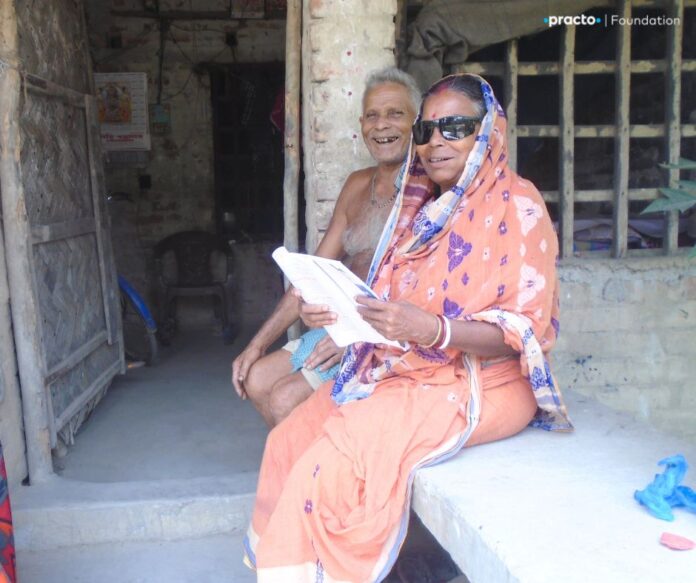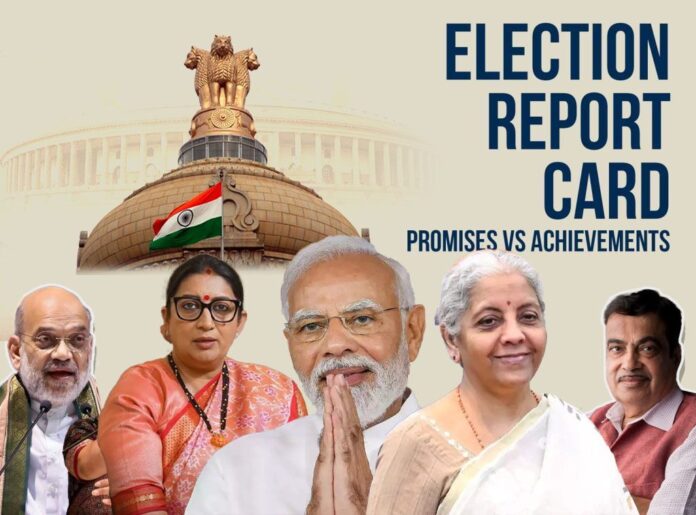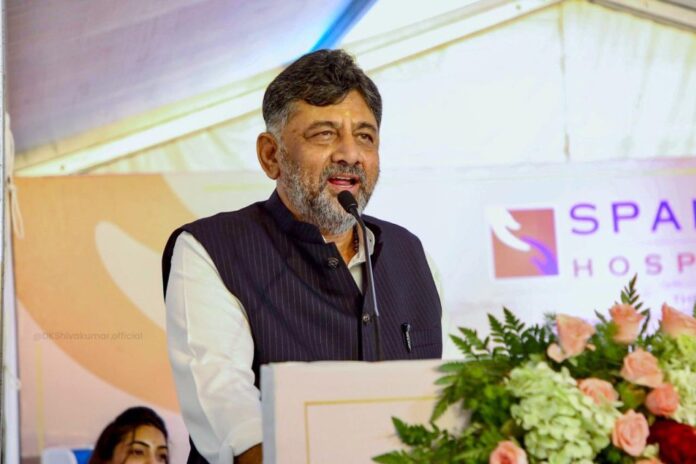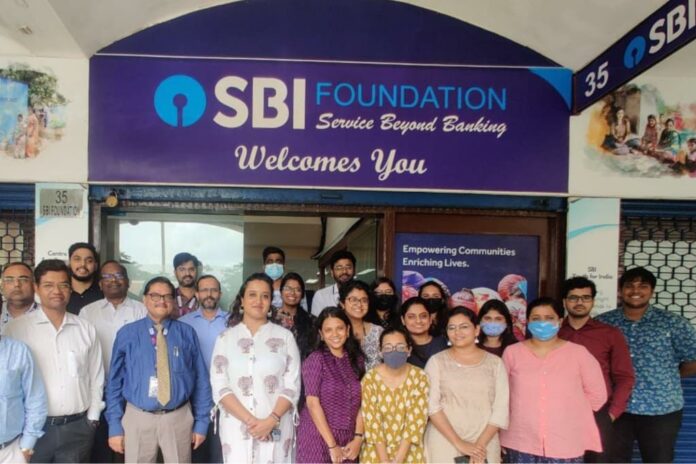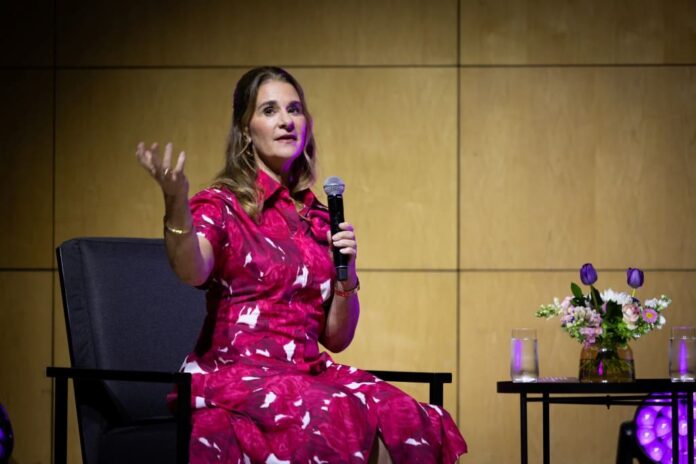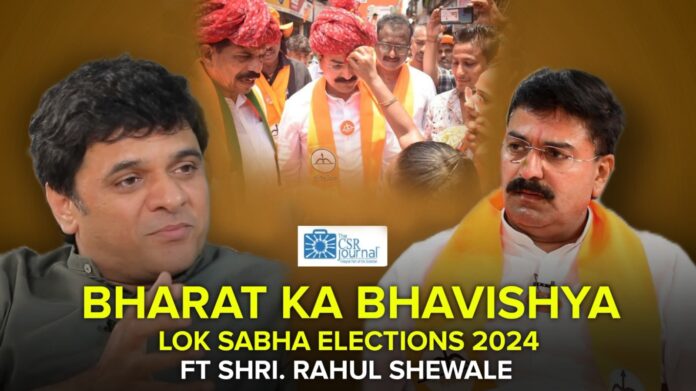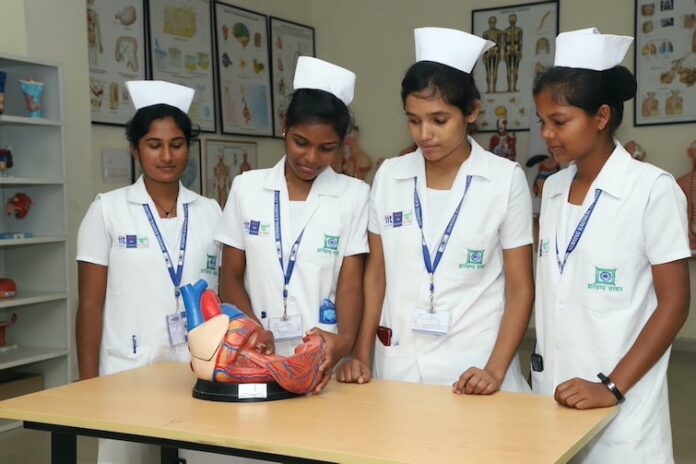Election Report Card: Promises vs Achievements under Good Governance
Election is a very important tool in democracy. It is through election that citizens of a nation choose their representatives and select their leaders. Political leaders represent different political parties which work for various goals.
In the general election held in 2014, the BJP-led NDA secured 282 seats and formed the government, making Narendra Modi the Prime Minister of India, while in the 2019 elections the number of seats went up to 303. The much-awaited Lok Sabha Elections 2024 commenced from 19th April, for which Prime Minister Narendra Modi has set a target of 370 seats for the ruling BJP and 400 seats for the NDA.
As we go through Lok Sabha Elections 2024 barely a month away, how to decide which political party you should cast your vote for? How to know how much work the party in power has done as against the tall claims that were made right before the previous elections?
The CSR Journal, which is known for its unbiased and fearless journalism delves into promises made versus task completed by the Bharatiya Janata Party (BJP), which is incumbent at the Centre under the leadership of Prime Minister Narendra Modi.
Following are certain promises made under the BJP’s manifesto ahead of the Lok Sabha Elections 2019. How much of the promises have been achieved in the past 5 years? Were the decisions made by the government beneficial for its people? Are citizens happy with what the government has to offer? What is the opposition saying? The CSR Journal takes a look.
BJP Manifesto – Lok Sabha 2019
Promises made by the Narendra Modi Government for: Good Governance
Simultaneous Elections
Corruption-free Bharat
Civil Service and Governance Reforms
Police Reforms
Judicial Reforms
International Financial Services Centre Authority
Implementing Cooperative Federalism Eectively
Ease of Living
Science and Technology
Forest and Environment
Protecting the Himalayas
Focussing on Island Territories
Focussing on Union Territories
Development of Noheastern States
Simultaneous Elections
The Indian government’s promise of implementing simultaneous elections for Parliament, state assemblies, and local bodies, along with the creation of a single voter list, has faced significant challenges in its implementation. The idea behind simultaneous elections was to reduce the massive expenditure incurred in holding frequent elections, ensure efficient utilization of government resources and security forces, and enable effective policy planning without being hindered by the model code of conduct that comes into force during election periods.
However, the implementation of this idea requires a constitutional amendment, which necessitates building a broad consensus among political parties. Despite the government’s efforts to advocate for simultaneous elections, there has been a lack of consensus among various parties, with several raising concerns about the feasibility and implementation challenges of such a system. Opposition parties have expressed apprehensions about the potential impact on the federal structure and the autonomy of states.
Regarding the commitment to a single voter list, the Election Commission of India (ECI) has been working towards creating a unified voter database by linking voter IDs with Aadhaar (the unique identification number). This effort aims to eliminate confusion caused by multiple voter lists and ensure that every citizen can exercise their franchise for all public bodies. However, the process of creating a truly single voter list across all levels of elections is still ongoing and faces logistical and administrative complexities, given the vast scale of the exercise and the need for coordination among various election authorities.
Despite the government’s commitment to these electoral reforms, the progress has been slow due to the need for constitutional amendments, building political consensus, and overcoming administrative and logistical challenges. The government continues to engage with various stakeholders, including political parties and election authorities, to build consensus and pave the way for the implementation of simultaneous elections and a single voter list.
Corruption-free Bharat
The Indian government has taken several legislative and executive measures to combat corruption, but the promise of a “Corruption-free Bharat” (India) remains a work in progress with significant challenges. Here’s an analysis of the government’s efforts and the current status:
The government enacted several laws to strengthen the legal framework against corruption, such as the Fugitive Economic Offenders Act, 2018, which allows for confiscation of properties of economic offenders who flee the country, the Prevention of Corruption (Amendment) Act, 2018, which criminalizes giving bribes to public servants, and the Benami Transaction Prohibition (Amendment) Act, 2016, which aims to curb the practice of holding properties under pseudonyms or proxy names.
Additionally, the government has taken administrative measures like demonetization in 2016, which aimed to curb black money and corruption, and the implementation of the Goods and Services Tax (GST) to simplify the tax regime and reduce leakages. The government has also emphasized the use of technology and digitalization to enhance transparency and reduce human intervention in various processes, such as the DigiLocker initiative and the Direct Benefit Transfer (DBT) scheme.
However, despite these efforts, corruption remains a significant challenge in India. Several high-profile corruption cases involving political leaders, bureaucrats, and business figures have surfaced, highlighting the deep-rooted nature of the problem. The perception of corruption in public services and institutions remains a concern, as highlighted by India’s ranking in global corruption indices like Transparency International’s Corruption Perceptions Index.
Furthermore, the implementation and enforcement of anti-corruption laws have faced challenges, with concerns raised about the effectiveness of investigative agencies and the pace of judicial processes. There have also been criticism from opposition parties and civil society organizations about the government’s perceived selectivity in targeting political opponents in corruption cases.
While the government has demonstrated a commitment to combating corruption through legislative and administrative measures, the promise of a “Corruption-free Bharat” remains an ongoing endeavor that requires sustained efforts, strengthening of institutions, and a comprehensive approach involving all stakeholders, including the public, private sector, and civil society.
Civil Service and Governance Reforms
The Indian government’s promise of civil service and governance reforms, guided by the principle of “Minimum Government and Maximum Governance,” has seen modest progress but faces ongoing challenges in its implementation. The government has emphasized the need to streamline bureaucratic processes, reduce red tape, and improve the efficiency of governance mechanisms. However, the size of the government machinery has not witnessed significant downsizing, and the principle of minimal government has not been fully realized.
In an effort to enhance policy coordination and implementation, the government has merged some ministries and departments with complementary or overlapping functions. Notable examples include the merger of the Ministries of Skill Development and Entrepreneurship, and Labor and Employment. However, the extent of such mergers has been limited, and the overall impact on policy coherence and coordination remains to be fully realized.
The government has also taken steps towards civil service reforms, such as promoting lateral entry into the civil services. This initiative aims to bring in domain experts and specialists from the private sector to supplement the existing pool of civil servants. However, this move has faced resistance from within the civil services, and the scale of lateral entry has been relatively small so far. Broader reforms, such as introducing performance-based incentives and accountability measures, are still in the discussion phase and yet to be implemented comprehensively.
In the realm of decentralized governance, the government has continued the Rashtriya Gram Swaraj Abhiyan (National Rural Self-Governance Campaign) to strengthen the capacity of Panchayati Raj Institutions (PRIs) and promote grassroots-level decision-making. However, the impact of this initiative has been uneven across states, and challenges persist in terms of devolution of powers, resources, and accountability mechanisms for PRIs.
The government has also prioritized the promotion of digital governance and e-governance initiatives to improve service delivery and enhance transparency. Initiatives such as the Digital India program, DigiLocker, and the Unified Mobile Application for New-age Governance (UMANG) have been launched. However, the adoption and implementation of these initiatives across various levels of government remain a work in progress, with varying degrees of success.
Overall, while the Indian government has demonstrated a commitment to civil service and governance reforms through various initiatives, the progress has been gradual and faces significant challenges. Factors such as resistance to change, bureaucratic inertia, and the need for broader political consensus have slowed the pace of reforms. Continued efforts, sustained political will, and a comprehensive approach involving all stakeholders are necessary to achieve substantial progress in transforming governance and service delivery mechanisms across the country.
Police Reforms
The Indian government’s promise to bring about comprehensive police reforms and transform the police force into a more citizen-friendly and modern institution has faced significant challenges in its implementation. Despite recognizing the need for reforms in a police system that still bears the imprint of its colonial legacy, the progress made so far has been limited and uneven across various aspects of the reform agenda.
One of the key promises made by the government was to formulate a ‘Model Police Act’ in consultation with states, aimed at establishing a uniform and progressive legal framework for policing across the country. However, no such comprehensive Model Police Act has been introduced or enacted at the national level so far. While some states have taken initiatives to update their respective police acts, the lack of a uniform national framework has hindered the pace and consistency of reforms.
The government has undertaken initiatives to modernize and upgrade the infrastructure and equipment of police forces across the country through various centrally sponsored schemes. Efforts have also been made to enhance the training and capacity building of police personnel, particularly in areas like cybercrime, forensics, and investigation techniques. However, the pace of modernization and capacity building has been uneven across different states and union territories, with some lagging behind due to resource constraints and other challenges.
A long-standing demand from civil society organizations and other stakeholders has been the establishment of robust accountability and oversight mechanisms to address issues of police misconduct and human rights violations. While some states have set up police complaint authorities and other accountability measures, a comprehensive national-level framework is still missing. Concerns persist regarding the autonomy and independence of these oversight bodies, as well as their effectiveness in ensuring accountability.
The police force in India continues to face challenges related to manpower shortages, poor working conditions, and a lack of adequate representation of marginalized communities. While the government has taken initiatives to address these issues, such as increasing the recruitment of women and members of underrepresented groups, these efforts need further strengthening to create a truly representative and inclusive police force.
Despite efforts towards modernization and capacity building, the public perception of the police force and its trustworthiness remains a concern in many parts of the country. Incidents of alleged police excesses, human rights violations, and lack of accountability have contributed to erosion of public trust in some cases. Building and maintaining public confidence in the police force is crucial for effective law enforcement and maintaining social order.
Overall, while the government has recognized the need for police reforms and taken some steps towards modernization and capacity building, the implementation of comprehensive and far-reaching reforms has been slow. Challenges persist in areas such as legislative frameworks, accountability mechanisms, human resource management, and building public trust. Continued efforts, sustained political will, and collaboration with stakeholders, including civil society organizations, are essential to achieve meaningful police reforms in line with the government’s promise and meet the challenges of policing in the 21st century.
Judicial Reforms
The Modi government had identified judicial reforms as a key focus area during its second term starting in 2019. On simplifying procedural laws, a significant step was the 2020 Tribunals Reforms Act, which aimed to streamline the functioning of various judicial tribunals and reduce delays. Efforts were also made to digitize court records and proceedings to enable smoother access and functioning. However, comprehensive reforms in this area are still awaited.
Regarding encouraging mediation and alternative dispute resolution (ADR) mechanisms, the government promoted these as a means to reduce the burden on courts. However, a robust and comprehensive policy framework to institutionalize mediation across all levels of the judiciary was still lacking. The progress in this area was considered slow by many experts and stakeholders.
In terms of strengthening judicial and court management systems, the government launched initiatives like the Tele-Law scheme to provide accessible legal aid services. There were also efforts to fill vacancies in the judiciary, but a significant number of positions remained vacant across different levels. Infrastructure development and digitization of courts continued, but at a pace that drew criticism from some quarters for being too slow.
On making India a hub for arbitration services, the government amended the Arbitration and Conciliation Act in 2021 to encourage institutional arbitration and make India an attractive destination for arbitration. Steps were taken to establish dedicated arbitration centers, but their effectiveness and impact remained to be seen.
Overall, while the Modi government made some progress on its judicial reform agenda during its second term, the implementation was often criticized as sluggish, and many of the promised reforms were still works in progress. Judicial reforms are a complex and ongoing process, and sustained efforts would be needed to achieve the stated goals effectively. The government’s initiatives in this area would need to be further accelerated and expanded to bring about transformative changes in the judicial system.
International Financial Services Centre Authority
The Indian government had long envisioned establishing the country as a hub for international financial services, aiming to attract global institutions and transactions. To achieve this goal, the government announced plans to set up a dedicated regulatory authority to oversee the operations of International Financial Services Centres (IFSCs) within India. This promise was fulfilled in April 2020 when the cabinet approved the establishment of the IFSC Authority, headquartered at the Gujarat International Finance Tec-City (GIFT City) in Gandhinagar.
The primary objectives of the IFSC Authority were to create a world-class regulatory framework consistent with international best practices and to oversee the functioning of financial products, services, and institutions within the IFSCs. This included framing regulations for various segments such as banking, capital markets, insurance, and funds. The Authority was also tasked with facilitating the establishment and operation of international financial services entities within the IFSCs, providing an efficient regulatory environment to attract global financial services and transactions.
Since its establishment, the IFSC Authority has made progress in fulfilling its mandate. It has framed regulations for various financial services segments within the IFSCs, enabling the entry and operation of international players in these domains. The Authority has also taken steps to promote the development of innovative financial products and services tailored to the needs of the IFSCs.
However, the effectiveness of the IFSC Authority in positioning India as a major international financial hub is still being assessed. While the regulatory framework has been established, attracting significant inflows of global financial institutions and transactions to the IFSCs remains an ongoing challenge. Efforts are underway to market the IFSCs and highlight the advantages offered by the regulatory environment created by the IFSC Authority.
Overall, the Indian government delivered on its promise of establishing the IFSC Authority, setting up the necessary regulatory infrastructure to facilitate the development of International Financial Services Centres within the country. However, the larger goal of transforming India into a leading international financial services center is a work in progress. The success of this endeavor will depend on the continued efforts of the IFSC Authority, in collaboration with other stakeholders, to promote and develop the IFSCs as attractive and globally competitive destinations for financial services and transactions.
Implementing Cooperative Federalism Eectively
The government made efforts to promote cooperative federalism through initiatives like the creation of NITI Aayog, establishment of the GST Council, and restructuring of central schemes. However, the effectiveness of these measures in strengthening federal dynamics has been a subject of debate.
NITI Aayog: Replacing the Planning Commission, NITI Aayog was formed to serve as a think tank and provide policy inputs to the states. However, its advisory role and lack of financial powers limited its impact on promoting cooperative federalism.
GST Council: The Goods and Services Tax (GST) Council, comprising representatives from the Center and states, was established to discuss and decide GST-related matters. While it facilitated center-state cooperation on GST implementation, concerns were raised over the council’s voting mechanisms and the perceived centralization of powers.
Restructuring of Central Schemes: The government restructured several centrally sponsored schemes, increasing the share of funding from states. This was aimed at giving states greater flexibility and ownership. However, some states criticized the Center for imposing conditions and reducing their fiscal autonomy.
14th Finance Commission Recommendations: The government implemented the 14th Finance Commission’s recommendations, which increased the share of states in the divisible pool of central taxes from 32% to 42%. This move was widely appreciated as a step towards fiscal federalism.
However, there were concerns over the curtailment of states’ powers in certain areas, such as the Center’s interventions in agricultural markets and the proposed changes to the All India Service cadres.
Overall, while the government made efforts to promote cooperative federalism through institutional mechanisms and policy measures, the implementation was seen as uneven by several states. Concerns were raised over the perceived centralization of powers in certain domains, and the need for more substantive consultation and collaboration with states on key policies was highlighted.
Cooperative federalism requires continuous dialogue, trust-building, and a balanced approach to address the concerns of states while also maintaining national priorities. The government’s performance in this area was a mixed bag, with both positive steps and areas that required further improvement.
Ease of Living
Recognizing the need to simplify citizen-government interactions and enhance the delivery of public services, the Indian government announced initiatives to improve the ‘Ease of Living’ for its citizens. A key step in this direction was the establishment of the Committee for Easing Citizens’ Interactions with Government (CECIG) in 2022. This committee was tasked with identifying and recommending reforms across various domains, such as taxes, business compliance, and rules and regulations, to make interactions with the government more user-friendly and straightforward.
To facilitate paperless interactions and digitize citizen services, the government launched several digital platforms and initiatives, including DigiLocker, the Umang app, and various e-governance services. These platforms aimed to provide citizens with a seamless and convenient way to access and interact with government services, reducing the need for physical documentation and visits to government offices. However, the implementation and adoption of these initiatives varied across different states and sectors, with some regions and departments being more successful than others in leveraging these digital tools.
Progress was made in areas such as online tax filing and business compliance, where the government introduced streamlined processes and digital interfaces to simplify these interactions for citizens and businesses. However, many complex regulatory processes and procedures remained cumbersome, with citizens often facing challenges in navigating bureaucratic hurdles and red tape.
To address the issue of timely delivery of public services, several states enacted the Right to Service Act, which mandated the provision of government services within specified time frames. However, the implementation and enforcement of this Act faced significant challenges, with many states struggling to ensure consistent and timely service delivery across various departments and agencies.
In an effort to address citizen grievances and improve accountability, the government launched the Centralized Public Grievance Redress and Monitoring System (CPGRAMS). This platform aimed to provide citizens with a centralized mechanism to register and track their complaints and grievances related to government services. However, the effectiveness of this system varied, with concerns raised about the responsiveness and resolution rates of grievances across different departments and states.
Overall, while the Indian government made efforts to improve the ‘Ease of Living’ for citizens through various initiatives, the impact and implementation of these measures were uneven across the country. While digital platforms and citizen-centric services were introduced, their adoption and effectiveness in simplifying citizen-government interactions remained a work in progress. Challenges persisted in areas such as complex regulatory processes, inconsistent implementation of the Right to Service across states, and the need for more comprehensive reforms to truly enhance the ‘Ease of Living’ for citizens in their interactions with the government. Sustained efforts, including streamlining of processes, capacity building, effective monitoring mechanisms, and a focus on last-mile implementation, would be required to fully realize the government’s promise in this area.
Science and Technology
The government recognized the importance of science and technology for the country’s development and made concerted efforts to promote cutting-edge research and innovation. The launch of the National Mission on Interdisciplinary Cyber-Physical Systems (NM-ICPS) was a significant step towards fostering research in emerging technologies like artificial intelligence, robotics, and the Internet of Things. However, the impact and outcomes of this mission are yet to be fully realized.
To promote research and development (R&D) across the country, the government established the National Research Foundation (NRF) to fund and support research initiatives in partnership with state governments and industries. This aimed to extend S&T investment beyond central institutions to state-level institutions as well. However, the implementation and funding allocation for the NRF faced delays, hampering its intended impact.
Initiatives like the National Language Translation Mission and the Genome Mission were launched to promote language translation and genomic research, respectively. While these missions showed promise, their progress and outcomes remained limited as of the time my knowledge cutoff.
The government also announced ambitious missions in areas such as ocean exploration, non-fossil fuel research, supercomputing, artificial intelligence, quantum computing, and semiconductor manufacturing. While some progress was made, many of these missions were still in their early stages, and their eventual success remained to be seen.
On the space front, the government successfully executed the anti-satellite missile test, Mission Shakti, demonstrating its technological capabilities. However, the ambitious Gaganyaan human spaceflight mission faced delays and setbacks, with its timeline pushed back.
Overall, the Indian government recognized the importance of science and technology and launched various initiatives and missions to promote research and innovation. However, the implementation and outcomes of these efforts were mixed, with some initiatives showing promise while others faced challenges or delays. Sustained focus, adequate funding, and effective execution would be crucial to fully realizing the government’s ambitious promises in the realm of science and technology.
Forest and Environment
The government claimed to have expedited the process of issuing forest and environmental clearances for eligible projects, leading to an increase of around 9000 sq. km in the country’s forest cover. However, this claim faced criticism from environmentalists and experts who raised concerns over the potential impact of fast-tracked clearances on ecological safeguards and the quality of environmental assessments.
Regarding air pollution, the government did make efforts to map pollution levels in cities and rivers using technological solutions. The National Clean Air Programme (NCAP) was launched to tackle air pollution in 102 most polluted cities. However, the implementation and effectiveness of NCAP remained a concern, with many cities continuing to grapple with severe air quality issues, and the promised 35% reduction in pollution levels over five years appearing ambitious.
On the positive side, the government focused on providing basic amenities, such as roads, telephone connectivity, cooking gas connections, houses, and toilets, to forest-dwelling communities, particularly tribal populations. This effort aimed to improve the living conditions of these marginalized groups while also promoting their interests. However, the extent and impact of these initiatives varied across different regions and communities.
Overall, while the government made some efforts to address environmental concerns and support forest-dwelling communities, its performance in this area was mixed. The expedited clearance process raised concerns among environmentalists, and the targets for reducing air pollution in major cities appeared challenging. The initiatives for forest-dwelling communities were well-intentioned, but their impact remained uneven. Sustained and more comprehensive efforts would be required to effectively address the complex issues of environmental conservation and the welfare of forest-dwelling populations.
Protecting the Himalayas
The government had announced its intention to provide special financial assistance in the form of a ‘Green Bonus’ to Himalayan states to facilitate the protection and promotion of forests in the ecologically sensitive Himalayan region. However, the implementation of this promise faced challenges and delays.
While the concept of a ‘Green Bonus’ was welcomed by the Himalayan states, the lack of a clear framework and criteria for disbursement of funds hindered its effective implementation. There were concerns raised by state governments and environmental organizations regarding the absence of a defined mechanism to calculate and allocate the ‘Green Bonus’ funds.
Some progress was made in the form of increased budgetary allocations for environmental protection and conservation projects in Himalayan states. However, these allocations were not explicitly labeled or structured as a ‘Green Bonus’ scheme, making it difficult to assess the specific impact of the promised financial assistance.
Additionally, there were concerns raised about the need for a more comprehensive approach to protect the Himalayas, including measures to address issues such as climate change, urbanization, and sustainable development in the region, rather than solely relying on financial incentives.
Overall, while the government’s intention to provide a ‘Green Bonus’ to Himalayan states was a positive step towards recognizing the importance of conserving the Himalayan ecosystem, the actual implementation of this promise faced challenges and fell short of expectations. A clear framework, well-defined criteria, and a holistic approach involving stakeholder consultation and coordination would be necessary to effectively protect the Himalayas and incentivize conservation efforts in the region.
Focussing on Island Territories
The government took steps to prioritize the development of India’s island territories, recognizing their economic potential and strategic importance. One of the key initiatives was the establishment of the Island Development Authority (IDA) in 2017, with the aim of ensuring the overall development of these regions through a focused and coordinated approach.
However, the progress made by the IDA in achieving its objectives has been relatively slow. While some infrastructural projects and initiatives related to tourism promotion were undertaken, the pace of development fell short of expectations. Concerns were raised about the need for more comprehensive and sustainable development plans that strike a balance between economic growth and preserving the unique ecological and cultural identities of these islands.
The government’s commitment to preserving the unique identities of Andaman and Nicobar Islands and Lakshadweep was laudable, but the implementation of practical measures to achieve this goal remained a challenge. Issues such as the impact of tourism on the local ecosystem, the protection of indigenous communities, and the preservation of traditional livelihoods continued to be areas of concern.
Overall, while the government recognized the importance of developing the island territories and took initial steps in that direction, the progress made was relatively modest. Stakeholders and experts highlighted the need for a more holistic and sustainable approach that prioritizes the well-being of the local communities, environmental conservation, and responsible tourism development. Stronger coordination between various agencies, adequate funding, and active involvement of local stakeholders would be crucial to fully realize the government’s promise of focusing on the development of these strategically important island territories.
Focussing on Union Territories
The government’s commitment to developing Union Territories as models of development and good governance received mixed reviews. While some progress was made in certain areas, the overall performance fell short of the ambitious promise.
In terms of infrastructure development, the government allocated funds and initiated various projects aimed at improving connectivity, housing, and public amenities in UTs like Jammu and Kashmir, Ladakh, Puducherry, and the Andaman and Nicobar Islands. However, the pace of implementation and the impact of these projects varied across different UTs, with some regions benefiting more than others.
Regarding the delivery of citizen services, the government introduced several digital initiatives and e-governance platforms to enhance accessibility and transparency. However, the adoption and effectiveness of these initiatives were uneven, with concerns raised about the digital divide and the need for capacity building, especially in remote areas of UTs.
Good governance and administrative reforms were also on the agenda, with efforts made to streamline processes and improve accountability. However, the impact of these measures was often criticized as being inadequate, with issues of corruption, bureaucratic inefficiencies, and lack of public participation in decision-making persisting in certain UTs.
The government’s approach towards UTs like Jammu and Kashmir and Ladakh, particularly after the abrogation of Article 370, drew significant criticism from various quarters. While the government defended its actions as necessary for development and good governance, concerns were raised about the erosion of autonomy, human rights violations, and the lack of meaningful political engagement with stakeholders.
Overall, while the government made efforts to develop UTs and introduce governance reforms, the progress was uneven and fell short of the promised models of development and good governance. Sustained efforts, adequate resources, and a more inclusive approach involving local stakeholders would be necessary to fully realize the government’s vision for the Union Territories.
Development of Noheastern States
The government made efforts to address the long-standing issues of insurgency and security concerns in the Northeastern states. Through a combination of security operations and peace talks with various groups, the overall security situation in the region improved compared to previous decades. This relatively stable environment was intended to pave the way for accelerated development initiatives.
In terms of infrastructure development and connectivity, the government allocated funds and launched projects to improve road, rail, and air connectivity within the Northeastern states and with the rest of the country. However, the progress on many of these projects was slower than anticipated, with issues such as land acquisition, challenging terrain, and limited resources posing hurdles.
Efforts were also made to tap into the region’s potential in sectors such as hydroelectric power generation, tourism, and horticulture. However, the success of these initiatives was hampered by factors like inadequate infrastructure, lack of skilled workforce, and limited private investment in the region.
The government reiterated its commitment to protecting the unique linguistic, cultural, and social identities of the Northeastern states. However, concerns were raised by various stakeholders about the lack of meaningful consultation and inclusion of local communities in the decision-making processes affecting their lives and traditions.
Overall, while the government made some progress in addressing security concerns and initiating development projects in the Northeastern states, the pace and impact of these efforts fell short of expectations. Challenges persisted in areas such as infrastructure development, tapping into the region’s economic potential, and ensuring the protection of local identities. A more comprehensive and inclusive approach, involving active participation of local stakeholders and addressing deep-rooted issues, would be necessary to fully realize the government’s promise of accelerated development in the Northeastern states.
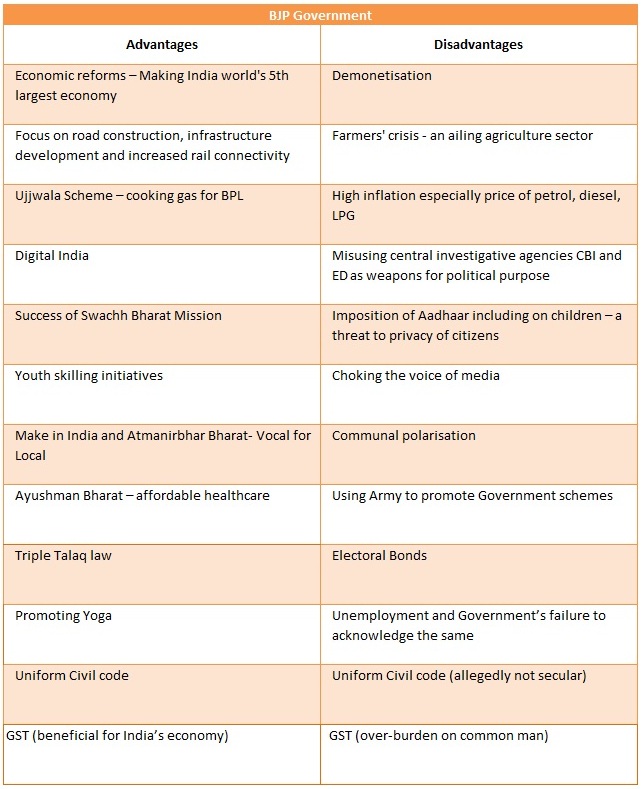
The CSR Journal
Eager to develop Govt Schools with CSR funds: Karnataka Deputy CM DK Shivakumar
Karnataka Deputy Chief Minister DK Shivakumar has once again expressed his desire to develop Government schools in the state with CSR support. While felicitating Secondary School Leaving Certificate (SSLC) examination toppers from government schools at his Bengaluru residence on Tuesday, Shivakumar announced his plan to upgrade government schools utilising CSR funds instead of relying on funds from the state.
The deputy CM expressed that State government is trying to implement a new education system. He also spoke about his plans to provide international quality education to Govt School students in rural areas of Karnataka by developing infrastructure of these schools with CSR funds.
The minister expressed his desire to host a meeting on the development of government schools after the Model Code of Conduct is withdrawn post the Lok Sabha Elections. The Model Code of Conduct lays down a list of do’s and don’ts for political parties and leaders ahead of elections and also restricts the government from announcing policy decisions.
20 Govt Schools in Ramanagara district being upgraded
Meanwhile, DK Shivakumar informed that work is already in progress for upgrading 20 government schools in Ramanagara district. The minister had earlier announced that the government will provide land in the range of 2-4 acres for each school, and companies will construct the schools on the assigned land with their CSR funds. Each school will be equipped with classrooms, a library, a laboratory, toilets, staff rooms, etc. Top-quality schools for the government will be constructed with CSR funds. Each school is expected to cost between Rs 4-7 crore.
CSR commitment of Rs 2000 cr
In November last year, speaking at the inauguration of the three-day long Bangalore Tech Summit, the Deputy Chief Minister made an appeal to technology companies to invest their CSR funds for development of rural schools in Karnataka. “I have had discussions with several people including Rishad Premji of Wipro and they have committed to invest Rs 2000 crores to improve the quality of education in rural areas. While companies are strengthening the finances of the government, the companies also expect some incentives from the government. We have to work together,” Shivakumar had said at the event.
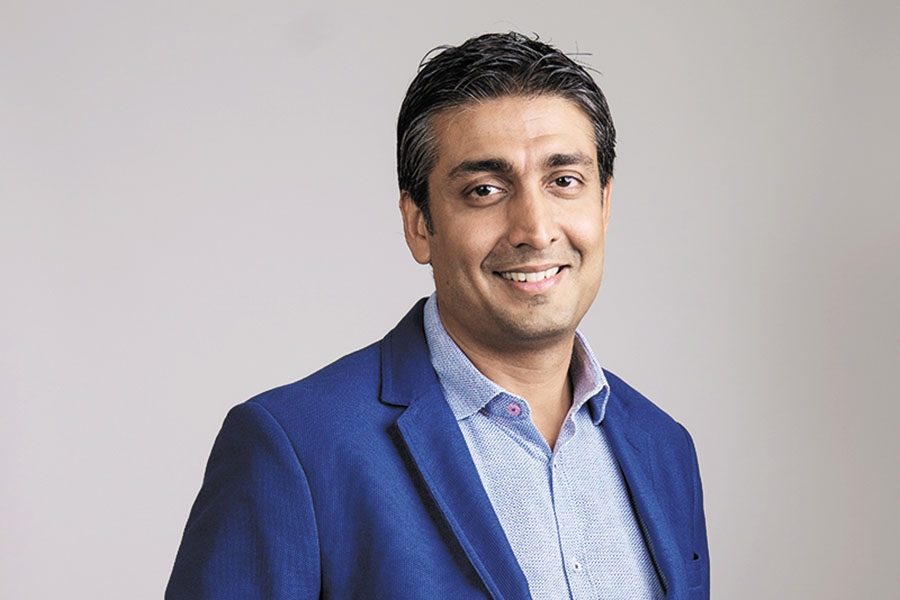
Aim is to prevent migration
“All Karnataka public schools will function as government schools, but the responsibility for education will be delegated to private educational institutions. We have already had a round of discussions with educational institutions. This initiative aims to prevent rural students from migrating to cities for better education. I have submitted a proposal to the Chief Minister to form a committee regarding this,” he had said.
Bengaluru – India’s IT hub
Further emphasizing the point that Bengaluru is India’s IT hub, the minister had said, “Bengaluru has earned its place in the world of technology. It is possible due to the ecosystem the city has to offer. Bengaluru and Karnataka have one of the highest numbers of engineering and medical colleges. Of the five million IT employees in India, two million are in Karnataka. No other State has so much human resource.”
Study reveals 68% of organizations in India rely on tech to drive sustainability success, spurred by customer demand
Bengaluru, India: Kyndryl, the world’s largest IT infrastructure services provider, in collaboration with Microsoft, today released the Asia Pacific edition of The Global Sustainability Barometer study. Conducted by Ecosystm, the study evaluates the sustainability landscape in India, the disparity between intent and operational implementation, and highlights how sustainability initiatives can stimulate innovation, foster growth and bolster competitiveness.
Amidst a surge in climate-related events and challenges globally, there is a heightened focus on environmental sustainability and leveraging technology as a key enabler of sustainable solutions in India. While 68% of the survey respondents see great significance in technology’s role in achieving their goals, only 34% believe they are making full use of it in their organization. Additionally, customers emerge as the most influential stakeholders advocating for sustainability (60%), followed by employees (52%) and supply chain partners (40%).
“Organizations are at diverse levels of sustainability maturity. Visionary companies are harnessing technology to meet regulatory standards and to pursue sustainability objectives effectively. They are leveraging technology to fulfill customer expectations, reduce expenses, and innovate, thereby unlocking the full potential of sustainability,” said Faith Taylor, Chief Sustainability and ESG Officer, Kyndryl.
The study outlines the essential components requisite for successfully executing a sustainability initiative: strategy, people, and technology. AI emerges as a game changer, as organizations can elevate their decision-making processes with refined data-driven insights, mitigate risks, optimize resource allocation, and bolster their overall sustainability efforts with the incorporation of predictive AI into sustainability strategies. However, accessing data still poses a significant challenge. Over 50% of organizations find their sustainability goals hindered by the difficulty in pinpointing relevant data and integrating all necessary information for environmentally conscious decision-making. This underscores the potential to establish a robust data infrastructure capable of powering predictive analytics for sustainable planning and resource management.
Other key findings of the survey include:
While 86% of organizations in India recognize the significance of sustainability in shaping business strategies, only 16% have prioritized sustainability goals and built them on real facts and data.
41% of organizations integrate sustainability initiatives in their reporting primarily for compliance.
The Indian government significantly influences sustainability adoption, with 89% of organizations acknowledging its role.
While 79% of organizations use AI to monitor energy usage and emissions, only 20% use it to predict future energy consumption, 26% for predicting and preparing for natural disasters, 26% to recognize inefficiencies and 28% to identify risks.
Drivers to Building a More Sustainable Organization
Below are sustainability best practices aimed at driving growth and improving business outcomes:
Make sustainability a CEO and Boardroom priority aligned with finance and technology – With over 55% of sustainability officers reporting to the CEO and the CEO defining the vision of sustainability programs in 93% of organizations, it’s clearly a top-down governance approach across Indian companies. However, only 17% of organizations report achieving full alignment between their sustainability and finance teams, highlighting an urgent need for enhanced integration. While a higher percentage, (39%) align sustainability teams with technology, there is a need for stronger alignment as technology driven measures are easier to quantify and drives innovation.
Align sustainability with technology modernization – Technology plays a pivotal role in automating, modernizing, and prioritizing sustainability processes and infrastructures. The study reveals that 56% of organizations in India leverage digital tools for hybrid work strategies and 55% use AI and automation to enhance efficiency, reduce environmental footprint and build sustainable operations.
Build an integrated data foundation – Streamlining data management to facilitate informed decision-making holds the key to the successful execution of strategies. However, the study highlights that only 11% of organizations in India offer their employees real-time dashboards for monitoring their ongoing sustainability goals and accomplishments.
Unleash AI for predictive sustainability – Considering the vast data resources available to organizations, the strategic imperative lies in harnessing predictive analytics for comprehensive scope 3 risk assessment, anticipatory energy consumption forecasting, and proactive measures against natural disasters. About 28% of organizations utilize AI to identify scope 3 risks using public sources, indicating a need for growing awareness of the broader environmental impact beyond direct operations.
Empower employees – While many organizations have made efforts to raise employee awareness and clarify their roles, the lack of measurement hinders the ability to link these efforts to overall progress. Only 14% of organizations set sustainability KPIs relevant to employee roles, indicating a need for clearer metrics and better alignment with employee responsibilities.
“India aims to reduce carbon intensity of economy by 45% by 2030 – this will require collective action from governments, industries, enterprises, and individuals,” said Ullrich Loeffler, Co-Founder & CEO, Ecosystm. “Together with Kyndryl and Microsoft, we are pleased to offer this study, providing forward-thinking organizations with actionable steps to drive measurable sustainability impact.”
The Global Sustainability Barometer study, conducted by Ecosystm in collaboration with Kyndryl and Microsoft, was conducted among 1,523 technology and sustainability business leaders across 16 countries in Asia, EMEA, and the Americas. The survey took place between September – October 2023. The survey was conducted across nine industries and included small to medium and global companies. Learn more about the study “From Vision to Impact: The Global Sustainability Barometer.”
Disclaimer: This media release is auto-generated. The CSR Journal is not responsible for the content.
SBI Foundation invites applications for Paid Fellowship in Rural Development for Fresh Graduates and Young Professionals
Mumbai, India: SBI Foundation, the CSR arm of State Bank Group, is inviting applications for the 12th edition of the Youth for India Fellowship program. The Fellowship provides a framework for educated urban youth, fresh graduates, or young professionals to join hands and foster change with rural communities and NGOs at the grassroots. Over the past 11 years, the SBI YFI through its various youth-led interventions has impacted over 150,000 lives in 250+ villages across 20 states.
The applicants for this 13-month Fellowship must be Indian Citizens, Overseas Citizens of India, or Citizens of Bhutan and Nepal. This is an opportunity to see to rural life from close and work towards sustainable rural development goals in conjunction with local communities and non-profits.
Youth for India Fellowship (Program of SBI Foundation) is inviting applications for a paid 13-month program on Rural Development
Eligibility: Bachelor’s Degree to be completed before 1st October 2024
Age criteria: 21 to 32 years
Who can apply: An Indian citizen, a citizen of Nepal/Bhutan, or an Overseas Citizen of India (OCI).
Application process: Stage 1 (Registration & Online Assessment),
Stage 2 (Personal Interview)
Application deadline: 21st May 2024
Web link:www.youthforindia.org/register

